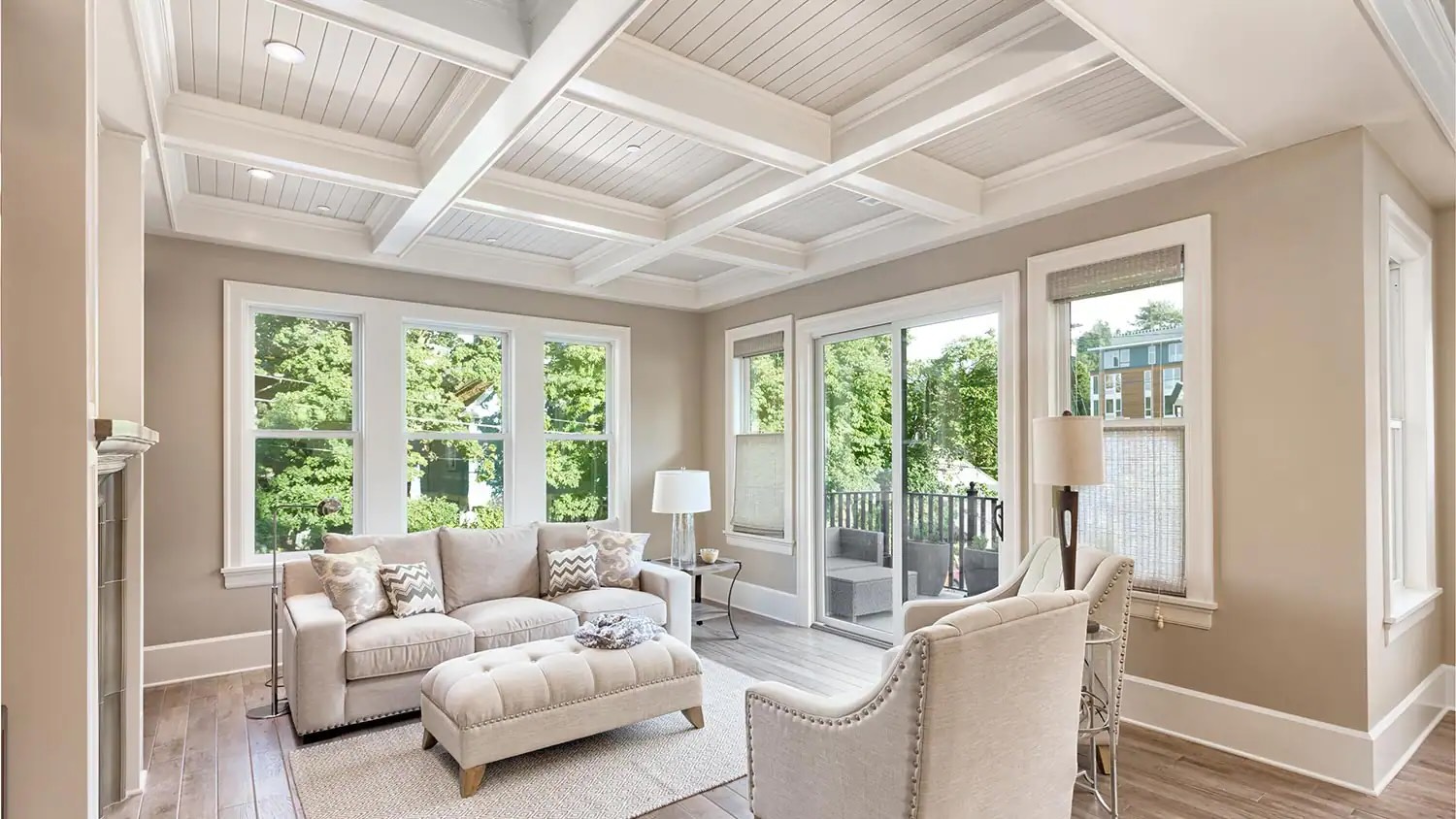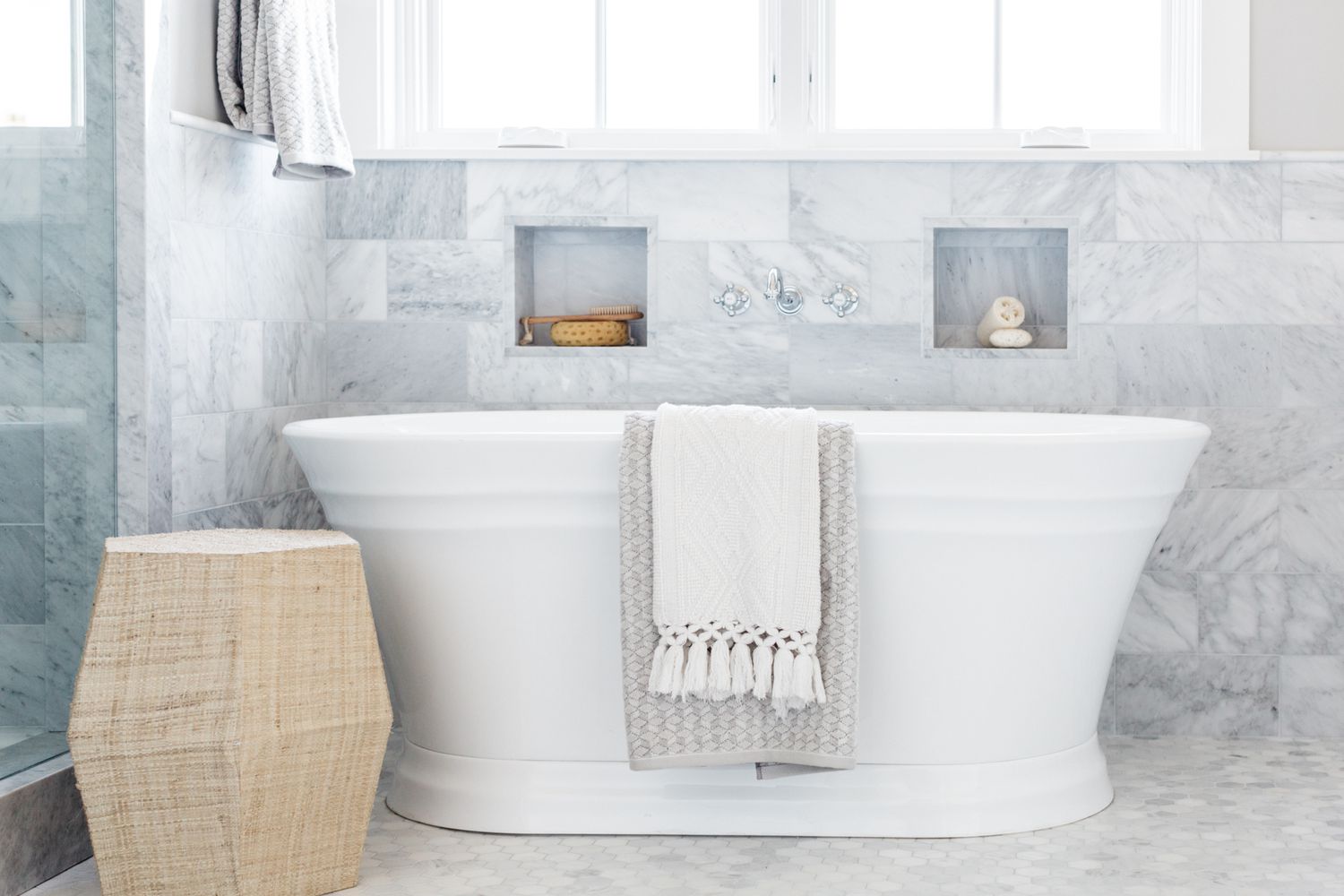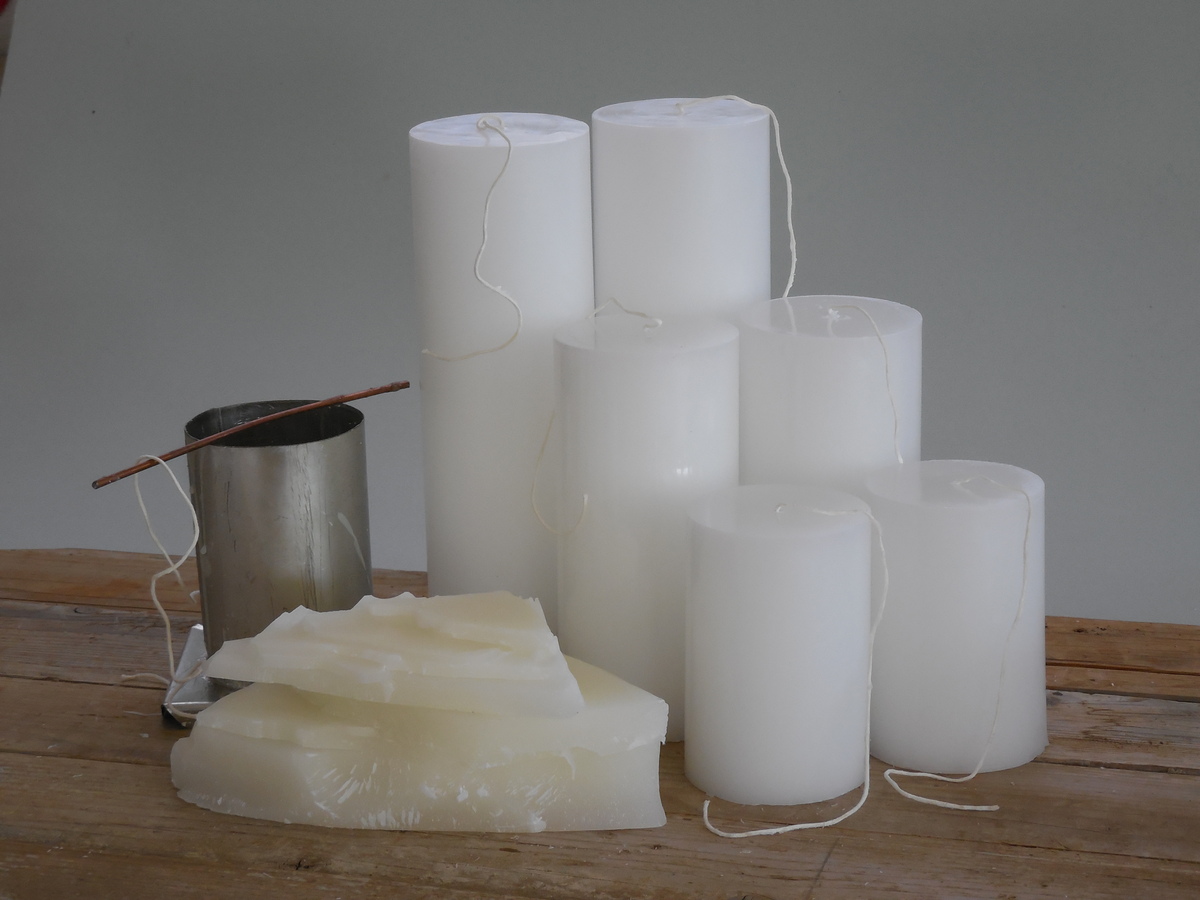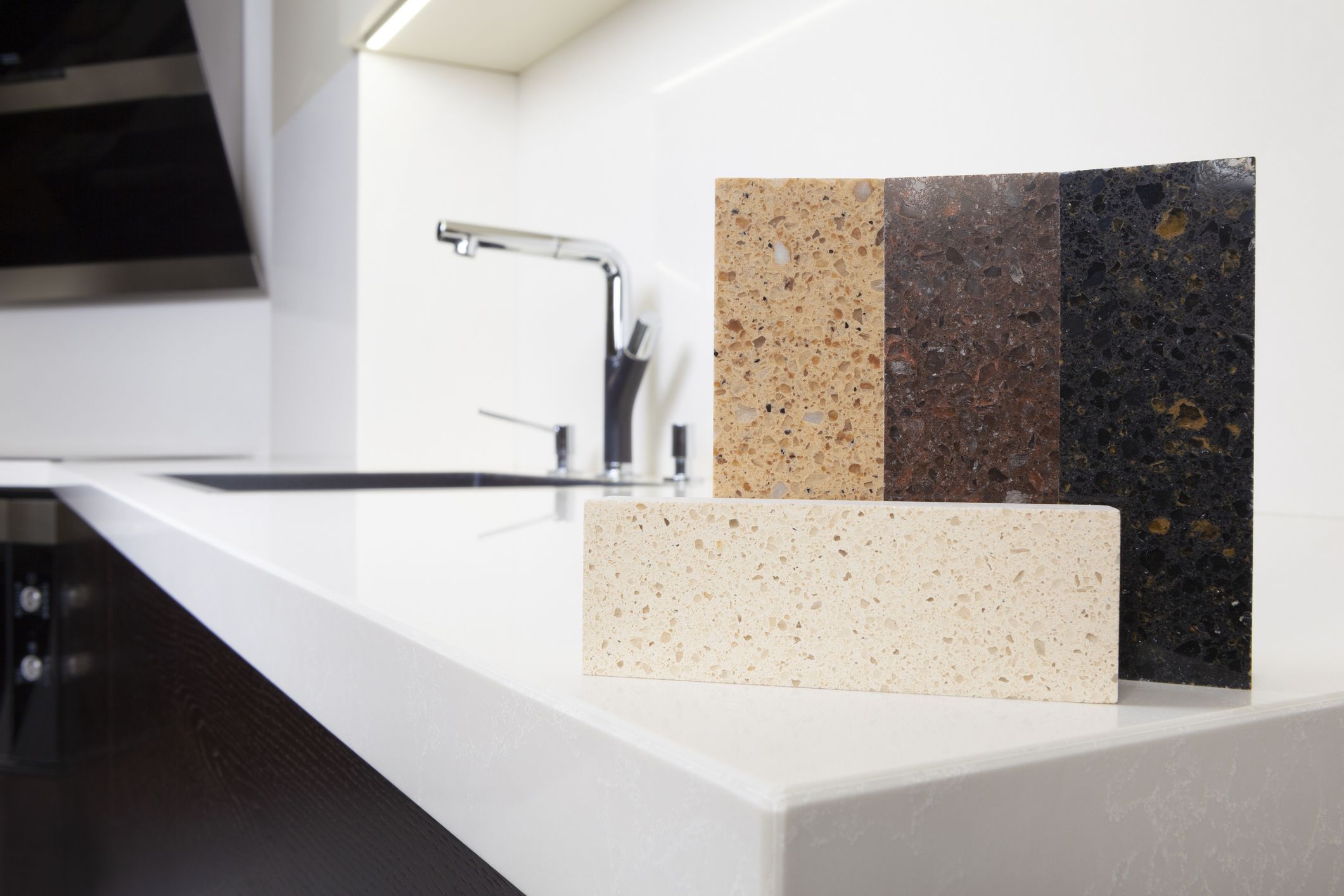

Articles
What Is A Ceiling Made Of
Modified: December 7, 2023
Learn about the materials used in ceiling construction in our informative articles. Discover what ceilings are made of and explore different options for your home or office.
(Many of the links in this article redirect to a specific reviewed product. Your purchase of these products through affiliate links helps to generate commission for Storables.com, at no extra cost. Learn more)
Introduction
When it comes to designing and decorating a space, one often overlooked element is the ceiling. While it might seem like a minor detail, the material used for the ceiling can have a significant impact on the overall aesthetic and functionality of a room. A well-chosen ceiling material can add character, improve acoustics, enhance insulation, and even provide a stunning visual focal point.
In this article, we will explore the various materials commonly used for ceilings and discuss the factors to consider when choosing the right one for your space. So, let’s dive in and discover what the ceiling is made of.
Key Takeaways:
- The choice of ceiling material impacts durability, aesthetics, acoustics, insulation, and maintenance. Consider factors such as resistance to cracks, sound absorption, thermal insulation, and cleaning requirements to make an informed decision.
- Each ceiling material offers unique benefits, from the elegance of plaster to the modernity of metal. Understanding the specific requirements of your space will help you select the ideal material for a functional and visually appealing ceiling.
Read more: What Is A Ceiling Tile Made Of
Common Materials Used for Ceilings
When it comes to choosing the material for your ceiling, you have several options to consider. Each material comes with its own unique characteristics and benefits, allowing you to select one that best suits your needs and design preferences. Here are some of the most common materials used for ceilings:
1. Plaster
Plaster is a traditional ceiling material that has been used for centuries. It is a mixture of gypsum, sand, and water that is applied in layers and then smoothed to create a seamless and elegant finish. Plaster ceilings are known for their durability and soundproofing qualities. They can also be molded into intricate designs, making them perfect for adding a touch of sophistication to a room.
2. Drywall
Drywall, also known as gypsum board or sheetrock, is a popular choice for modern ceilings. It is made from a layer of gypsum sandwiched between two layers of paper. Drywall ceilings are easy to install and provide a smooth and seamless surface. They can be painted or covered with wallpaper to match the overall decor of the room.
3. Wood
Wooden ceilings bring warmth and natural beauty to a space. They can be crafted from various types of wood, such as oak, cedar, or pine, each providing a different appearance and texture. Wood ceilings can be installed in the form of planks, panels, or even intricate beams, adding a rustic or elegant touch to the room’s design.
Read more: What Are Blinds Made Of
4. Metal
Metal ceilings offer a sleek and contemporary look. They can be made from materials like aluminum, tin, or steel and come in various finishes, including brushed, polished, or textured. Metal ceilings are known for their durability and resistance to moisture, making them a suitable choice for areas prone to humidity, such as bathrooms or kitchens.
5. Acoustic Tiles
Acoustic tiles, also known as acoustic panels or ceiling tiles, are specifically designed to improve sound quality and reduce noise levels in a room. These tiles are made from porous materials, such as mineral fiber or foam, that absorb sound waves. Acoustic tiles are commonly used in spaces where acoustic performance is crucial, such as recording studios, theaters, or conference rooms.
6. Fiberglass
Fiberglass ceilings offer a lightweight and durable solution. They are made from thin layers of woven glass fibers that are reinforced with resin. Fiberglass ceilings are known for their resistance to moisture, mold, and mildew, making them suitable for high-humidity areas like basements or bathrooms. They can also be customized with various textures and finishes to suit different design styles.
Plaster
Plaster is a traditional and versatile material that has been used for ceilings for centuries. It is a mixture of gypsum, sand, and water that is applied in layers and then smoothed to create a seamless and elegant finish. Plaster ceilings have several advantages that make them a popular choice for many homeowners and designers.
One of the main benefits of plaster ceilings is their durability. When properly installed and maintained, plaster ceilings can last for decades without showing signs of wear or deterioration. They are resistant to cracks, dents, and stains, making them a reliable option for long-term use.
In addition to their durability, plaster ceilings are also known for their excellent soundproofing qualities. The thick layers of plaster help to absorb and dampen sound, reducing echoes and improving acoustics in a room. This makes them ideal for spaces where noise control is important, such as theaters, music rooms, or libraries.
Furthermore, plaster ceilings offer a wide range of design possibilities. They can be molded and sculpted into intricate patterns, adding a touch of elegance and sophistication to any room. Whether you prefer classic ornamental details or a more modern and minimalist look, plaster ceilings can be customized to match your aesthetic preferences.
However, it’s worth noting that plaster ceilings require professional installation due to the complex application process. The layers of plaster need to be applied correctly and allowed to dry and cure thoroughly to ensure a solid and smooth surface. Hiring an experienced plaster craftsman or contractor is crucial to achieve the best results.
In terms of maintenance, plaster ceilings are relatively low-maintenance. Regular dusting and occasional cleaning with a mild detergent and water solution are usually sufficient to keep them looking their best. However, it’s important to avoid using abrasive cleaners or scrubbing too vigorously, as this can damage the plaster surface.
Overall, plaster ceilings offer a timeless and elegant option for both traditional and contemporary interiors. Their durability, soundproofing properties, and design versatility make them a popular choice among homeowners and designers who value quality and craftsmanship.
Read more: What Is Cutlery Made Of
Drywall
Drywall, also known as gypsum board or sheetrock, is a commonly used material for ceilings in modern construction. It is made from a layer of gypsum sandwiched between two layers of paper. Drywall ceilings offer several advantages that make them a popular choice among homeowners and builders.
One of the main advantages of drywall ceilings is their ease of installation. Drywall is lightweight and can be easily cut to fit the dimensions of a room. It is typically screwed or nailed to a wooden or metal framework called studs or joists. This makes the installation process quicker and more efficient compared to other ceiling materials.
In addition to its ease of installation, drywall ceilings provide a smooth and seamless finish. The joints between the drywall sheets are covered with a joint compound and tape, creating a seamless surface. This allows for easy painting or applying wallpaper to achieve the desired aesthetic for a room.
Drywall ceilings also offer good fire resistance. Gypsum, the main component of drywall, is a naturally fire-resistant material. This means that drywall ceilings can help delay the spread of fire, providing valuable time for occupants to safely evacuate the building. Additionally, fire-rated drywall is available in the market, which offers even higher levels of fire resistance.
Furthermore, drywall ceilings have good acoustic properties. The porous nature of gypsum helps absorb sound waves, reducing echoes and improving the overall acoustics of a space. This makes drywall ceilings a popular choice for rooms where sound quality is important, such as home theaters or recording studios.
When it comes to maintenance, drywall ceilings are relatively low-maintenance. They are resistant to stains and can be easily cleaned with a damp cloth or sponge. However, drywall is more susceptible to physical damage compared to other ceiling materials, such as plaster or wood. It can be easily dented or cracked if not handled with care.
Overall, drywall ceilings offer a cost-effective and versatile option for modern homes and commercial spaces. Their ease of installation, smooth finish, fire resistance, and acoustic properties make them a practical choice for a wide range of applications. Whether you are building a new home or renovating an existing space, drywall ceilings provide a clean and modern look that can easily be customized to suit your design preferences.
Wood
Wooden ceilings bring natural warmth and charm to any space. They are a timeless and versatile option that can enhance the aesthetics of both traditional and contemporary interiors. Wood ceilings offer several advantages that make them a sought-after choice among homeowners and designers.
One of the main benefits of wood ceilings is their ability to create a cozy and inviting atmosphere. The natural grain and texture of wood add a sense of warmth and character to a room, making it feel more welcoming and comfortable. Wood ceilings can be crafted from various types of wood, including oak, cedar, pine, and many others, each with its own unique appearance and characteristics.
In addition to their aesthetic appeal, wood ceilings provide excellent durability. Wood is a strong and resilient material that can withstand the test of time. Properly maintained wood ceilings can last for decades, making them a long-term investment for your home.
Wooden ceilings also offer great versatility in terms of design. They can be installed in the form of planks, panels, or even intricate beams, allowing for a wide range of creative possibilities. Whether you prefer a rustic, farmhouse-inspired look or a modern and sleek design, wood ceilings can be customized to suit your style and preferences.
Furthermore, wood ceilings have natural insulating properties. Wood is an excellent insulator, which means that it can help regulate the temperature in a room. Wood ceilings can help keep the room cool during the summer and retain warmth during the winter, reducing the need for excessive heating or cooling.
When it comes to maintenance, wood ceilings do require periodic care to keep them in optimal condition. Regular cleaning and sealing can help prevent stains and protect the wood from moisture or insect damage. It’s important to follow the manufacturer’s guidelines for maintenance and use appropriate wood cleaning products.
Overall, wood ceilings offer a classic and timeless option for those looking to add natural beauty and warmth to their spaces. With their durability, versatility, and insulating properties, wood ceilings can elevate the design and atmosphere of any room, creating a cozy and inviting ambiance that will be enjoyed for years to come.
Metal
Metal ceilings have gained popularity in recent years for their sleek and contemporary look. They offer a unique and modern design option that can add an industrial or minimalist touch to any space. Metal ceilings are made from various materials such as aluminum, tin, or steel, and they come with several advantages that make them a preferred choice for many homeowners and designers.
One of the main benefits of metal ceilings is their durability. Metal is a strong and robust material that can withstand wear and tear over time. Metal ceilings are resistant to cracks, dents, and moisture, making them suitable for areas that experience high humidity, such as bathrooms or kitchens. Metal ceilings are also resistant to pests, such as termites, which can be a common problem with other ceiling materials.
Another advantage of metal ceilings is their ease of installation. Metal panels can be easily attached to the ceiling framework using screws or clips, making the installation process quick and efficient. Metal ceilings also come in a variety of sizes and styles, allowing for flexibility in design and customization.
Metal ceilings are known for their sleek and contemporary appearance. They can be finished in various ways, including brushed, polished, or textured, to achieve the desired look. Metal ceilings can create a sense of elegance and sophistication in a room, making them a popular choice for modern homes and commercial spaces.
In addition to their aesthetic appeal, metal ceilings offer excellent fire resistance. Metal does not burn, making metal ceilings a safe option in case of fire. They can help to prevent the spread of flames and contribute to the overall fire safety of a building. However, it’s important to note that metal ceilings can conduct heat, so additional insulation may be required in certain applications.
Maintenance for metal ceilings is relatively easy. They are resistant to stains and can be easily cleaned with a damp cloth or sponge. Periodic dusting is usually sufficient to keep them looking their best. However, it’s important to avoid using abrasive cleaners that can scratch the metal surface.
Overall, metal ceilings offer a contemporary and durable option for those looking to create a modern and stylish space. With their sleek appearance, fire resistance, and ease of installation, metal ceilings can add a touch of sophistication and elegance to any room, making them a popular choice for a range of interior designs.
Acoustic Tiles
Acoustic tiles, also known as acoustic panels or ceiling tiles, are specifically designed to improve sound quality and reduce noise levels in a room. They are made from porous materials such as mineral fiber or foam, which help absorb sound waves and reduce echoes. Acoustic tiles offer several advantages that make them a popular choice for spaces where acoustic performance is crucial.
One of the main benefits of acoustic tiles is their ability to improve sound quality. They absorb excess sound and reduce echoes, creating a more pleasant and balanced acoustic environment. This makes them ideal for spaces where noise control is important, such as recording studios, theaters, home theaters, classrooms, or conference rooms.
Acoustic tiles are available in various styles and designs, allowing for customization to suit different aesthetics. They can be installed in a grid pattern to create a uniform and sleek look or in more creative arrangements to add visual interest to a room. Acoustic tiles are also available in different colors, textures, and shapes, giving you the flexibility to choose a design that complements your overall decor.
In addition to their acoustic properties, acoustic tiles offer easy installation and maintenance. They are lightweight and easy to handle, making the installation process relatively straightforward. Acoustic tiles can be easily fixed to existing ceiling grids or directly mounted onto the ceiling surface. Maintenance typically involves regular dusting or vacuuming to remove accumulated dirt and debris.
Furthermore, acoustic tiles can also provide thermal insulation benefits. The porous nature of the materials used in acoustic tiles helps to regulate temperature and reduce heat transfer. This can improve energy efficiency and help maintain a comfortable indoor environment.
It’s worth noting that while acoustic tiles are effective at absorbing sound reflections within a room, they have limitations in blocking sound transmission between rooms. If significant soundproofing is required, additional soundproofing measures such as insulation or wall constructions may be necessary.
Overall, acoustic tiles offer a practical and aesthetically pleasing solution for improving sound quality in various spaces. With their ability to absorb sound, customizable designs, easy installation, and low maintenance requirements, acoustic tiles make it possible to achieve optimal acoustics and create a pleasant and enjoyable environment for any room.
Read more: What Is Insulation Made Of
Fiberglass
Fiberglass ceilings are a lightweight and durable option that offers versatility in both design and functionality. They are made from thin layers of woven glass fibers that are reinforced with resin. Fiberglass ceilings have several advantages that make them a popular choice for residential and commercial spaces.
One of the main benefits of fiberglass ceilings is their resistance to moisture and humidity. Unlike other ceiling materials that can warp or deteriorate in damp environments, fiberglass ceilings are highly resistant to moisture, mold, and mildew. This makes them a suitable choice for areas with high humidity, such as basements, bathrooms, or swimming pool enclosures.
Fiberglass ceilings are also known for their durability. The combination of woven glass fibers and resin provides strength and stability, allowing fiberglass ceilings to withstand physical impact and resist damage over time. They are less prone to cracking, chipping, or sagging, providing a long-lasting and reliable ceiling solution.
Another advantage of fiberglass ceilings is their versatility in design. They can be customized with various textures, finishes, and patterns to suit different aesthetic preferences. Whether you prefer a smooth and sleek surface or a textured and patterned look, fiberglass ceilings can be manufactured to achieve the desired visual effect.
In addition to their aesthetic appeal, fiberglass ceilings offer sound absorption properties. The woven glass fibers in fiberglass ceilings help to absorb sound waves, reducing echoes and improving the overall acoustics of a room. This makes them a suitable choice for spaces where noise control is important, such as offices, schools, or restaurants.
Fiberglass ceilings also provide thermal insulation benefits. The layered construction of fiberglass helps to trap air pockets, which act as insulation. This can improve energy efficiency by reducing heat transfer and maintaining a comfortable indoor temperature.
Maintenance for fiberglass ceilings is relatively easy. They are resistant to stains and can be easily cleaned with a damp cloth or sponge. Regular dusting is usually sufficient to keep them looking their best. However, it’s important to avoid using abrasive cleaners or harsh chemicals that can damage the fiberglass surface.
Overall, fiberglass ceilings offer a lightweight, durable, and versatile option for various applications. Their resistance to moisture, durability, customizable designs, sound absorption properties, and thermal insulation benefits make them a practical choice for homeowners and designers looking for a reliable and aesthetically pleasing ceiling solution.
Factors to Consider in Choosing Ceiling Materials
When choosing the right ceiling material for your space, there are several factors to consider. Each factor plays a crucial role in determining the functionality, aesthetics, and overall satisfaction with your chosen ceiling material. Here are some important factors to keep in mind:
1. Durability:
Consider the durability of the ceiling material. Will it withstand wear and tear over time? Some materials, such as plaster and fiberglass, are known for their durability and resistance to cracks, stains, and moisture. On the other hand, materials like wood may require more maintenance to preserve their condition.
2. Aesthetics:
Think about the desired look and feel of your space. Different ceiling materials offer various aesthetics. Plaster ceilings can provide a classic and elegant ambiance, while metal ceilings offer a sleek and contemporary look. Wood ceilings bring warmth and natural beauty, while drywall ceilings provide a smooth and seamless finish. Consider how the ceiling material will complement the overall style and design of your space.
Read more: What Is A Trampoline Made Of
3. Acoustics:
If sound quality and noise control are important to you, consider the acoustics of the ceiling material. Some materials, like acoustic tiles or fiberglass, are specifically designed to absorb sound waves and reduce echoes, creating a more pleasant and balanced acoustic environment. This is particularly important for spaces such as recording studios, home theaters, or conference rooms.
4. Insulation:
Consider the insulation properties of the ceiling material. Some materials, such as fiberglass or wood, offer natural insulation benefits, helping to regulate temperature and reduce heat transfer. This can contribute to energy efficiency and maintaining a comfortable indoor environment.
5. Maintenance:
Think about the maintenance requirements of the ceiling material. Some materials may require regular cleaning or sealing to keep them looking their best, while others may be more low-maintenance. Consider the effort and upkeep required to maintain the appearance and functionality of the ceiling material.
By carefully considering these factors, you can choose the right ceiling material that aligns with your needs, preferences, and the specific requirements of your space. Whether you prioritize durability, aesthetics, acoustics, insulation, or ease of maintenance, finding the perfect ceiling material will enhance the overall look and functionality of your room.
Durability
When choosing a ceiling material, one of the most important factors to consider is its durability. The durability of the ceiling material will determine how well it withstands wear and tear over time. It is essential to select a material that can withstand the conditions of the space and maintain its structural integrity. Here are some considerations regarding durability:
1.1. Resistance to Cracks and Damage:
The ceiling material should be resistant to cracks, dents, and other physical damage. This is especially important in high-traffic areas or spaces where there is a higher risk of impact, such as hallways or commercial spaces. Materials like plaster and drywall are known for their strength and ability to resist cracks, while metal ceilings offer excellent durability against impact.
1.2. Moisture Resistance:
In areas prone to moisture, such as bathrooms or kitchens, it is important to choose a ceiling material that is resistant to moisture damage. Materials like fiberglass or metal are highly resistant to moisture and will not warp or deteriorate when exposed to high humidity levels. On the other hand, materials like wood may require additional sealing or treatment to withstand moisture effectively.
1.3. Longevity:
Consider the lifespan of the ceiling material. How long can you expect it to last without significant deterioration or the need for frequent repairs? Plaster and drywall ceilings have a long lifespan, often lasting several decades with proper maintenance. Wood ceilings, while durable, may require more regular maintenance and refinishing to ensure their longevity.
1.4. Resistance to Stains:
Choose a ceiling material that is resistant to stains and discoloration. This is especially important in spaces like kitchens or areas prone to frequent spills. Materials such as metal or fiberglass are more resistant to staining, while porous materials like wood or acoustic tiles may require additional protective coatings.
1.5. Climate Considerations:
Consider the climate of your location and how it may affect the durability of the ceiling material. For example, in areas with high humidity, materials like plaster or metal are more suitable due to their moisture resistance. In regions with extreme temperature fluctuations, it is important to choose a material that can handle expansion and contraction without cracking or warping.
By considering the durability of the ceiling material, you can select a long-lasting and sturdy option that can withstand the demands of your space. Remember to assess the specific requirements and conditions of the room to ensure that the chosen material will provide the desired durability and maintain its aesthetic appeal over time.
Read more: What Is Silverware Made Of
Aesthetics
When choosing a ceiling material, the aesthetic appeal it brings to the space is an important factor to consider. The ceiling material has a significant impact on the overall look and feel of the room. It should enhance the desired design style and complement the existing decor. Here are some elements to consider regarding aesthetics:
2.1. Style and Design:
Consider the overall style and design theme of the space. Is it modern and sleek, rustic and cozy, or classic and sophisticated? The ceiling material should align with the chosen style and enhance the visual appeal of the room. For example, plaster ceilings with ornate details are ideal for creating a more elegant and traditional look, while metal ceilings can provide a contemporary and industrial feel.
2.2. Texture and Finish:
Think about the desired texture and finish of the ceiling. Some materials, such as wood or plaster, offer natural textures that add depth and character to the space. Others, like metal or fiberglass, can be finished in various ways, such as brushed, polished, or textured, to create a specific look and feel. Consider how the texture and finish will contribute to the desired aesthetic effect.
2.3. Color and Customization:
Some ceiling materials offer more flexibility in terms of color and customization. For example, drywall ceilings can be easily painted to match the room’s color scheme, while acoustic tiles or metal ceilings may come in a variety of colors and finishes. Consider how the color and customization options of the ceiling material will integrate with the overall design scheme.
2.4. Ceiling Height and Perception:
The choice of ceiling material can also influence how the height of the space is perceived. Light-colored materials or reflective finishes can create an illusion of higher ceilings and make the room feel more spacious. On the other hand, darker or textured materials may create a cozier and more intimate atmosphere in rooms with higher ceilings.
2.5. Cohesion with the Room’s Purpose:
Consider how the ceiling material will contribute to the overall ambiance and purpose of the room. For example, in a home theater, acoustic tiles or materials with sound-absorbing properties can enhance sound quality. In a restaurant or retail space, a unique and visually striking ceiling material can create a memorable and immersive experience for customers.
By carefully considering the aesthetics of the ceiling material, you can create a visually pleasing and harmonious space that reflects your design preferences. Take into account the style, texture, color, and overall atmosphere you want to achieve, and select a ceiling material that complements and enhances the desired aesthetic appeal of the room.
Acoustics
When selecting a ceiling material, the acoustics of the space should be taken into consideration. The acoustics refer to how sound behaves within a room, including its reflection, absorption, and transmission. Choosing the right ceiling material can greatly impact the acoustics and improve the sound quality in a space. Here are some factors to consider regarding acoustics:
3.1. Sound Absorption:
Certain ceiling materials, such as acoustic tiles or panels, are designed specifically to absorb sound waves, reducing echoes and improving the overall acoustics of a room. These materials are often made from porous materials like mineral fiber or foam that help trap and dissipate sound energy. Spaces where effective sound absorption is important, such as recording studios, theaters, or conference rooms, would benefit from such materials.
3.2. Noise Control:
Consider the level of noise control required for the space. In areas where noise needs to be minimized or controlled, such as offices or classrooms, choosing a ceiling material with good sound insulation properties is essential. Materials like plaster or drywall, when combined with insulation materials, can help reduce sound transmission from one room to another, providing better privacy and reducing distractions.
3.3. Reverberation Control:
Reverberation refers to the persistence of sound in a room after the source has stopped, resulting in a longer decay time or echo. Spaces where speech intelligibility or music quality is critical, such as lecture halls or music studios, require ceiling materials that can minimize reverberation. Acoustic tiles, panels, or perforated metal ceilings, which have high sound absorption coefficients, are effective in reducing reverberation and creating a more acoustically balanced environment.
3.4. Sound Reflection and Diffusion:
The ceiling material plays a role in how sound is reflected and dispersed within a room. Smooth and hard surfaces, like metal or glass, tend to reflect sound, which can result in excessive reverberation or energy build-up. On the other hand, materials with uneven or textured surfaces, such as certain types of wood ceilings, can help scatter or diffuse sound, creating a more pleasant listening environment.
3.5. Room Size and Purpose:
The size and purpose of the room should also be taken into account when considering the acoustics. Larger rooms or spaces with high ceilings may require different acoustical treatment to control reflections and echoes compared to smaller, more intimate rooms. The intended use of the room, whether it’s for music, speech, or multi-purpose activities, will also influence the desired acoustical properties of the ceiling material.
By carefully considering the acoustics of the space, you can choose a ceiling material that optimizes the sound quality and creates a more comfortable and functional environment. Whether you need sound absorption, noise control, or reflection management, selecting a ceiling material that addresses these acoustic factors will contribute to creating an acoustically pleasing and enjoyable space.
Insulation
Insulation is an important factor to consider when choosing a ceiling material, as it can impact the energy efficiency and comfort of a space. The right ceiling material can help regulate temperature, reduce heat transfer, and contribute to better insulation. Here are some considerations regarding insulation:
4.1. Thermal Insulation:
Certain ceiling materials, such as fiberglass or foam-based options, offer excellent thermal insulation properties. These materials have the ability to trap air pockets within their structure, which act as insulators. They can help prevent heat from escaping during colder months and can keep the interior cool during warmer seasons. This can result in energy savings and a more comfortable living or working environment.
4.2. Energy Efficiency:
A properly insulated ceiling can contribute to overall energy efficiency in a space. By reducing heat transfer through the ceiling, less energy is required for heating and cooling purposes. This can result in lower energy bills and a reduced carbon footprint. Look for ceiling materials with high R-values, which indicate their resistance to heat flow.
4.3. Climate Considerations:
The climate of the region should be taken into account when selecting an insulated ceiling material. In colder climates, choosing a material with high thermal resistance is crucial for maintaining a warm and comfortable interior. In warmer climates, selecting materials with high solar reflectance and thermal emissivity can help minimize heat gain from the sun.
4.4. Moisture Resistance:
Moisture can compromise the insulation properties of a ceiling material. It is important to choose a material that is resistant to moisture, especially in humid environments or areas prone to condensation. Materials like metal or fiberglass are typically less susceptible to moisture damage, while organic materials like wood may require additional treatment to preserve their insulation capabilities.
4.5. Air Leakage Prevention:
A well-insulated ceiling can help prevent air leakage, which can lead to energy loss and inefficient climate control. The chosen ceiling material should have good sealing capabilities to minimize air infiltration or exfiltration. Combine the ceiling material with proper sealing techniques, such as caulk or weatherstripping, to maximize insulation performance.
By selecting a ceiling material with good insulation properties, you can create a more energy-efficient and comfortable space. Customizing the insulation level based on the climate, considering thermal resistance, moisture resistance, and air leakage prevention will contribute to better insulation and energy savings. A well-insulated ceiling will help maintain a consistent and comfortable indoor environment, regardless of the weather conditions outside.
Ceilings are typically made of drywall, also known as plasterboard or gypsum board. It is a popular choice due to its affordability, ease of installation, and fire-resistant properties.
Maintenance
The maintenance requirements of a ceiling material are an important consideration when choosing the right option for your space. The level of maintenance needed can vary depending on the material, and it’s important to select a ceiling material that fits your lifestyle and maintenance preferences. Here are some factors to consider regarding maintenance:
5.1. Cleaning and Upkeep:
Consider the cleaning and upkeep required for the ceiling material. Some materials, such as metal or fiberglass, are easy to clean and maintain with regular dusting or wiping with a damp cloth. On the other hand, materials like wood or plaster may require more care and periodic cleaning with specific products. Consider the level of effort and time you are willing to invest in maintaining the appearance of the ceiling.
5.2. Stain Resistance:
Examine the stain resistance of the ceiling material. Spaces such as kitchens or dining areas are prone to spills and stains, and choosing a material that is resistant to stains can make maintenance easier. Materials like metal or fiberglass are typically more resistant to staining, while porous materials like wood or acoustic tiles may require additional protective coatings to prevent staining.
5.3. Repair and Replacement:
Consider the ease of repair and potential need for replacements in the future. Accidents or wear and tear can happen, and it’s important to understand the repair process for the chosen ceiling material. Materials like plaster or drywall may require patching or reapplication of joint compound if damaged, while wood or metal ceilings may require individual plank or panel replacements.
5.4. Lifespan and Durability:
Assess the lifespan and durability of the ceiling material. Some materials, like plaster or drywall, have long lifespans and can withstand everyday use without significant deterioration. Others, like wood or metal, may require occasional refinishing or repainting to maintain their appearance. Consider the long-term maintenance needs and the expected lifespan of the material before making a decision.
5.5. Finishes and Coatings:
Look into the finishes and coatings available for the ceiling material. Some materials may benefit from protective finishes, such as varnishes or sealants, to enhance durability and ease of maintenance. These finishes can provide additional protection against moisture, stains, or UV damage, depending on the specific material and its exposure conditions.
By considering the maintenance requirements of the ceiling material, you can choose an option that aligns with your capacity and preference for upkeep. Keep in mind the cleaning needs, stain resistance, repairability, durability, and potential finishes or coatings that can simplify maintenance. Selecting a ceiling material that matches your desired maintenance effort will help ensure a beautiful and well-maintained space for years to come.
Read more: What Is A Napkin Made Of
Conclusion
Choosing the right ceiling material is an important decision that can greatly impact the overall functionality, aesthetics, and comfort of a space. Each type of ceiling material offers unique characteristics and benefits, and considering various factors can help you make an informed choice.
Durability is a key factor to consider, as you want a ceiling material that can withstand wear and tear over time. Materials like plaster, drywall, wood, metal, fiberglass, and others each have their own level of durability and resistance to cracks, moisture, and physical damage.
The aesthetics of the ceiling material play a significant role in the overall design of the room. Whether you prefer a classic and elegant look with plaster, a sleek and modern feel with metal, or the natural warmth of wood, choosing a material that aligns with your style and complements the existing decor is essential.
Acoustics should also be considered, especially in spaces where sound quality and noise control are important. Materials like acoustic tiles or panels can significantly improve sound absorption and reduce echoes, creating a more pleasant environment for activities such as music, presentations, or conversations.
Insulation is another factor to keep in mind, as it can impact energy efficiency and the comfort of the space. Materials with good thermal insulation properties, such as fiberglass, can help regulate temperature and reduce heat transfer, resulting in energy savings and improved comfort.
Lastly, the maintenance requirements of the ceiling material should be evaluated. Consider the level of cleaning, stain resistance, repairability, and lifespan of the material to ensure that it fits well with your lifestyle and maintenance preferences.
In conclusion, selecting the right ceiling material involves considering factors such as durability, aesthetics, acoustics, insulation, and maintenance. By carefully weighing these factors and understanding your specific requirements for the space, you can choose a ceiling material that not only enhances the functionality and visual appeal of the room but also brings long-term satisfaction and enjoyment.
Frequently Asked Questions about What Is A Ceiling Made Of
Was this page helpful?
At Storables.com, we guarantee accurate and reliable information. Our content, validated by Expert Board Contributors, is crafted following stringent Editorial Policies. We're committed to providing you with well-researched, expert-backed insights for all your informational needs.










0 thoughts on “What Is A Ceiling Made Of”